Exploring the Imperial Cities of Morocco (Part 2)
By: Habeeb Salloum/Arab America Contributing Writer
In the Shadows of the Atlas Mountains

The April morning air was cool as we tried to find our seats in the CTM bus headed for Marrakesh. A half dozen women had taken over the front seats, not shown on their tickets. Whoever thinks Muslim women are docile should have seen these women establishing their rights to seats others had bought. In the end they had their way and everyone, including ourselves, took the leftover seats. No one seemed to mind. In a land where women are said to have no rights, this appeared strange indeed.
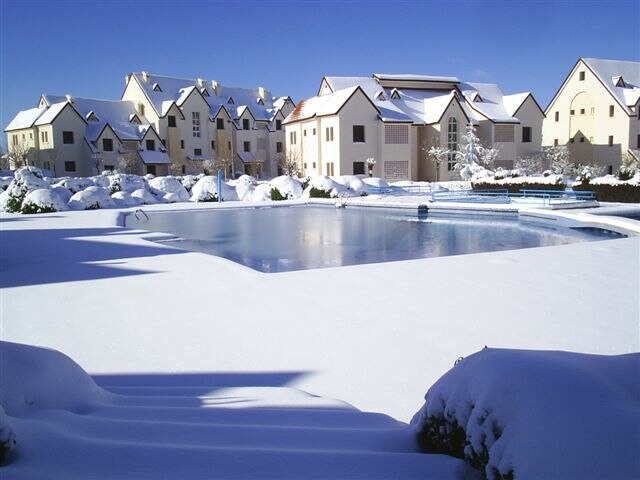
Our first stop after leaving Fez was Ifrane – Morocco’s skiing centre. This scenic town of winter sports is surrounded by forests of cedar, oak, and pine. With its steep red roofs, tree-lined streets and blooming gardens it appeared to be a European town from the Alps. Even the cool, dry, fragrant mountain breezes seemed to blow from the highlands of Europe. The air felt invigorating the few minutes we walked its streets enjoying this creation of nature and man.
Leaving Ifrane behind, we drove under the shadows of mountains until we reached Azrou – a Berber town famous for its handicrafts. Beautiful cedarwood carved objects and hand-woven carpets are produced by the artisans of this town. However, our short stop did not allow us time to buy some of these handmade souvenirs.
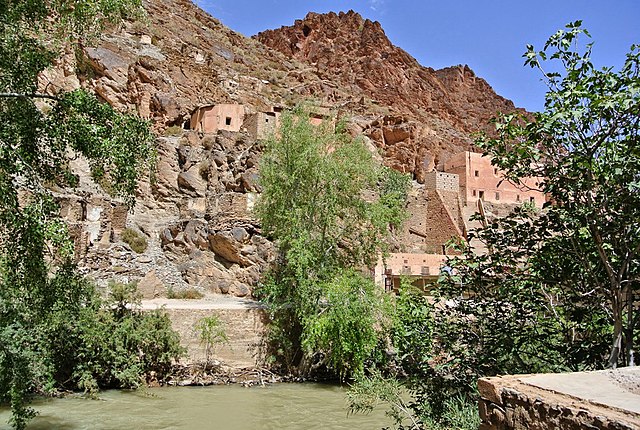
Our next halt was Khenifra – the Berber city of tree-lined streets. Some writers have labelled this town ‘Morocco’s cedar city’. Well they have a point, for barely 20 kilometres from its outskirts are acres of cedar forests. The hundreds of stately trees to be found in these woodlands put the cedars of Lebanon to shame.
Beyond Kenifra our bus crossed fertile plains around the sheep farming centre of Kasba Tadla. We did not stop but continued on through an irrigated countryside filled with fruit orchards until we reached Beni Mellal. We could see as we drove across this prosperous farming region that the watered land was being expanded day after day. To our unexperienced eyes it appeared to be the richest agricultural land in Morocco.
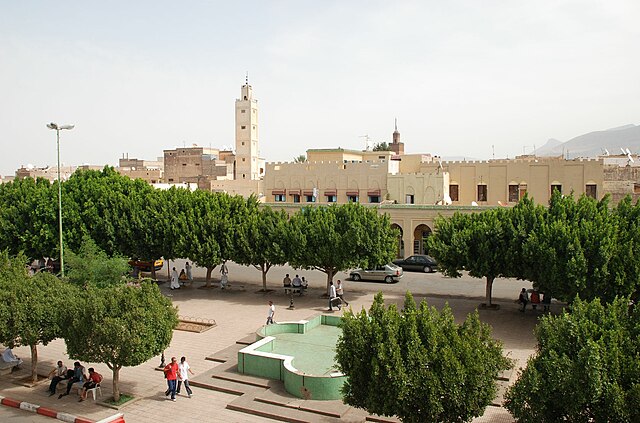
In Beni Mellal an old, yet modern town, we witnessed a traditional Berber wedding while we sipped Moroccan mint tea in a street side café. Colourfully dressed women, men playing the Berber music of the Atlas Mountains along with singers and dancers moved before our eyes in a splendid procession. The only concession to the modern age was the use of a truck to convey the bride and groom.
Some distance from Beni Mellal, when the green farmland turned to semi desert plains, I realized our last Imperial City was drawing near. I was elated. Visions of mighty sultans leading their armies, caravans richly laden and dazzling tiled palaces flowed through my mind. When the rugged snow-capped peaks of the High Atlas loomed majestically in the distance, I knew our last goal was in sight. Soon the arid countryside gave way to a blooming oasis in whose centre lay Marrakesh – the most fascinating and mysterious city in Morocco.
Marrakesh
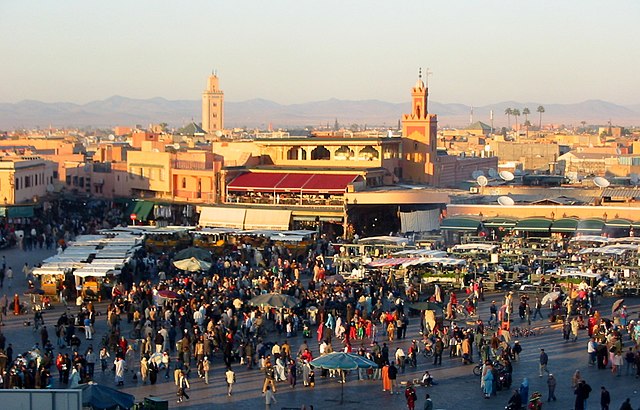
Darkness was beginning to creep in when our bus reached the fabled capital of Morocco’s south. I could hardly believe my eyes. The town appeared like an enchantress from the past ages as it was being covered by the setting sun. Surrounded by palm-groves to the north and east and nestled beneath the towering Atlas Mountains, without doubt, it is a city which would inspire a romantic poet.
We were bewitched by the breathtaking pink buildings and fruit laden trees as we drove through the new part of town along Avenue Muhammad V. On both sides of this main boulevard and adjoining streets ornamental lemon and orange trees lined these thoroughfares. The pink colour, scenic trees, setting sun with a background of snow-capped mountains formed a kaleidoscope of appealing shades – an exciting welcome for a traveller.
Marrakesh was founded by Yusuf Ben Tashfine, the first sultan of the Almoravide Dynasty. Later it was enhanced by the sultans of the Almohades and Saadians. Inside its walls were planned the military campaigns which held at bay for 200 years the Christian assaults against the last outpost of Islam in Spain. During these wars each one of the Almoravide and Almohade sultans had beautified and expanded the city – making it the most renowned world capital in its day. Later, the Saadians sultans and rulers of other dynasties which followed carried on the process of creating this beautiful Imperial Capital.
Dotting the city from these centuries of greatness are numerous impressive landmarks. The most famous is the Koutoubia Mosque. Its 223 feet high minaret, built in the Almohade era, dominates the town. The first sight of Marrakesh which a traveller coming across the plains beholds is this tower, visible many miles away. Historians and poets have never tired of glorifying this signpost of Marrakesh, erected in the 12th century by al-Mansur.
Ranking not far behind the Koutoubia in importance are the Saadian tombs. Built in the 16th century they are an epitome of Saadian art. Their mosaic walls and gilded carved cedarwood ceilings supported by marble columns are a delicate work of beauty. The Saadian Dynasty, not as lustrous as its predecessors, has left its mark in the tombs of its sultans.
Other structures from Marrakesh’s brilliant past are to be found in all parts of the city. The Ben Yusuf Madrasa richly ornamented with wood and plaster arabesques; Bahia Palace, a royal home noted for its Moorish gardens, lace stucco and ceramic tiles and; Dar Si Said, housing the Museum of Moroccan Art should be a part of an excursionist’s itinerary. Like us, a visitor will be enchanted with their symmetry and atmosphere. Besides these tourist attractions there are other homes and palaces equally as inviting. A number of these have been converted into tourist restaurants or places of entertainment.
Leaving the palaces of the wealthy behind, we moved into Jemma el Fna, Marrakesh’s main square near the Koutoubia. In the same fashion as other visitors, the square held us spellbound. Acrobats, fortune tellers, preachers, snake charmers, magicians, dancers, musicians, herbalists and food vendors mesmerized us. It was an unforgettable festival. Group after group of performers kept their circles of audiences under their spell. We felt unequivocally that this was the heart of traditional Morocco and one of the greatest entertainment centres in the world. The vividness of life is portrayed as no place else in the globe.
It was hard to tear ourselves away from the activities of the square. However, the adjoining medina, encompassed by thick pink walls, beckoned. In no time we were walking in its tangle of little streets, observing their vivid movements. The masses of people dressed in countless costumes were a delight to watch. Merchants, street vendors, city workmen and artisans all did their part in creating the colour and activity for which Marrakesh is famous.
When darkness descended, we enjoyed a delectable Moroccan meal in a former Moorish palace. Between its tiled walls and marble columns we were entertained with Berber dancing and Andalusian singing and music – developed in Moorish Spain. It was, truly, an historic evening in which we lived with the forgotten Moors of the Iberian Peninsula.
Before we departed from our last Imperial City, we toured the nearby Aguedal and Menara Gardens. It was a pleasure to stroll between their cypress edged olive and orange groves dotted with flower beds. As we rambled by the summer houses and artificial lakes set between the trees, we remembered the sultans from long ago. They must have loved beauty and atmosphere to conceive these seductive enclosures. With water, ornamental trees, shade and peacefulness these rulers had created their idea of Paradise. Today, thousands of tourists saunter in the shade of these tree-filled fields, once the exclusive monopoly of the privileged.
Hospitality of the Arabs
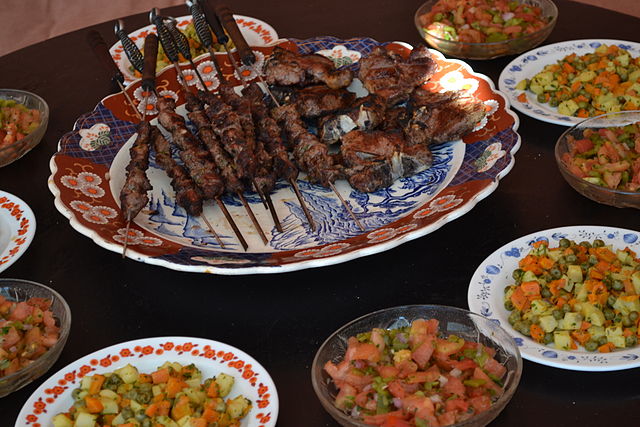
As our bus moved out of Morocco’s Citadel of sultans, I sat back and reflected on our journey through the legendary Imperial Cities. A smiling young man sitting beside me broke into my daydreams. “Did you enjoy your stay in this city from where our sultans once ruled powerful empires?” he asked in Classical Arabic.
“Of course, it is an attractive regal town, still carrying the aura of kings”, I was not being polite, only expressing my feelings.
Introductions were made and in no time, we were in deep conversation. Time passed quickly. It seemed that we had only been acquainted a few minutes when our bus stopped for lunch.
“Let us eat together”, my new-found companion invited us to eat lunch with him.
When I came to pay the bill for the hearty meal of tajine, a delicious Moroccan stew, the restaurant owner said it had already been looked after. Muhammad, whom I had known for a few hours, had made us his guests. When I protested, he was indignant, “You are my guests. Do you not know the code of hospitality by which we Arabs live?”
Living in the West all our lives, I had momentarily forgotten how guests are treated in the Arab lands. By befriending Muhammad in his country, we had become his guests, even on the road.
Casablanca: The Modern Imperial City
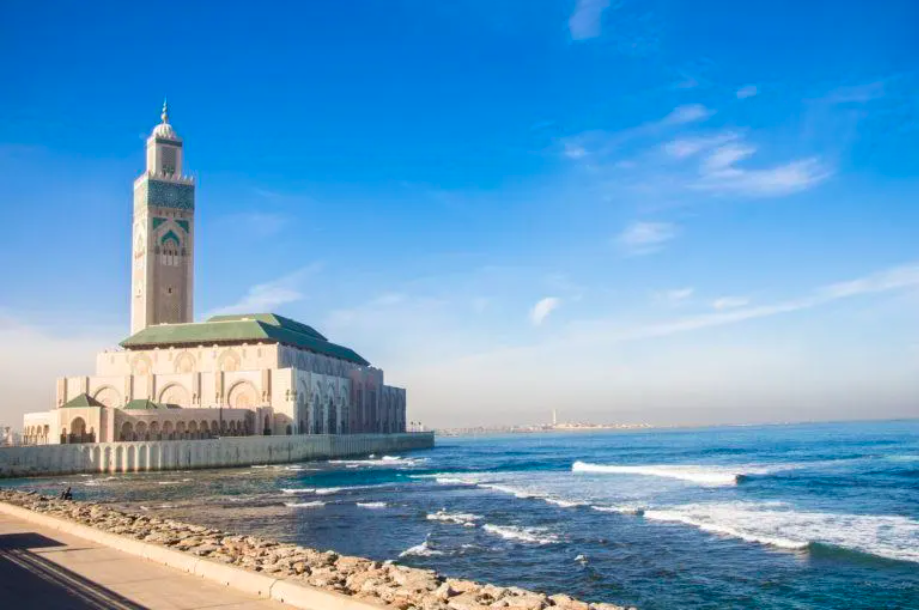
Sunset was near when we entered Casablanca, the modern commercial metropolis of Morocco. For tourists, the Imperial Cities with their historic monuments, traditions and colours are the places to visit. On the other hand, for Moroccans, Casablanca is their 20th century mecca. To this modern city peasants, labourers, and men of wealth have poured in never ending numbers. From a small hamlet they have created a commercial Imperial City of our modern age.
Casablanca was beautiful, but our interests were in the past. We did not tarry long before departure. As our plane soared away from Morocco’s industrial capital, I reflected, “How strange is man. Thousands of foreigners pour in to tread the streets of Morocco’s Imperial Cities while unnumbered |Moroccans leave these historic capitals, seeking in Casablanca prestige and wealth.” I thought, “Would this modern metropolis in time match the glory of the Imperial Cities?” There is only one answer, “Only time will tell. “


